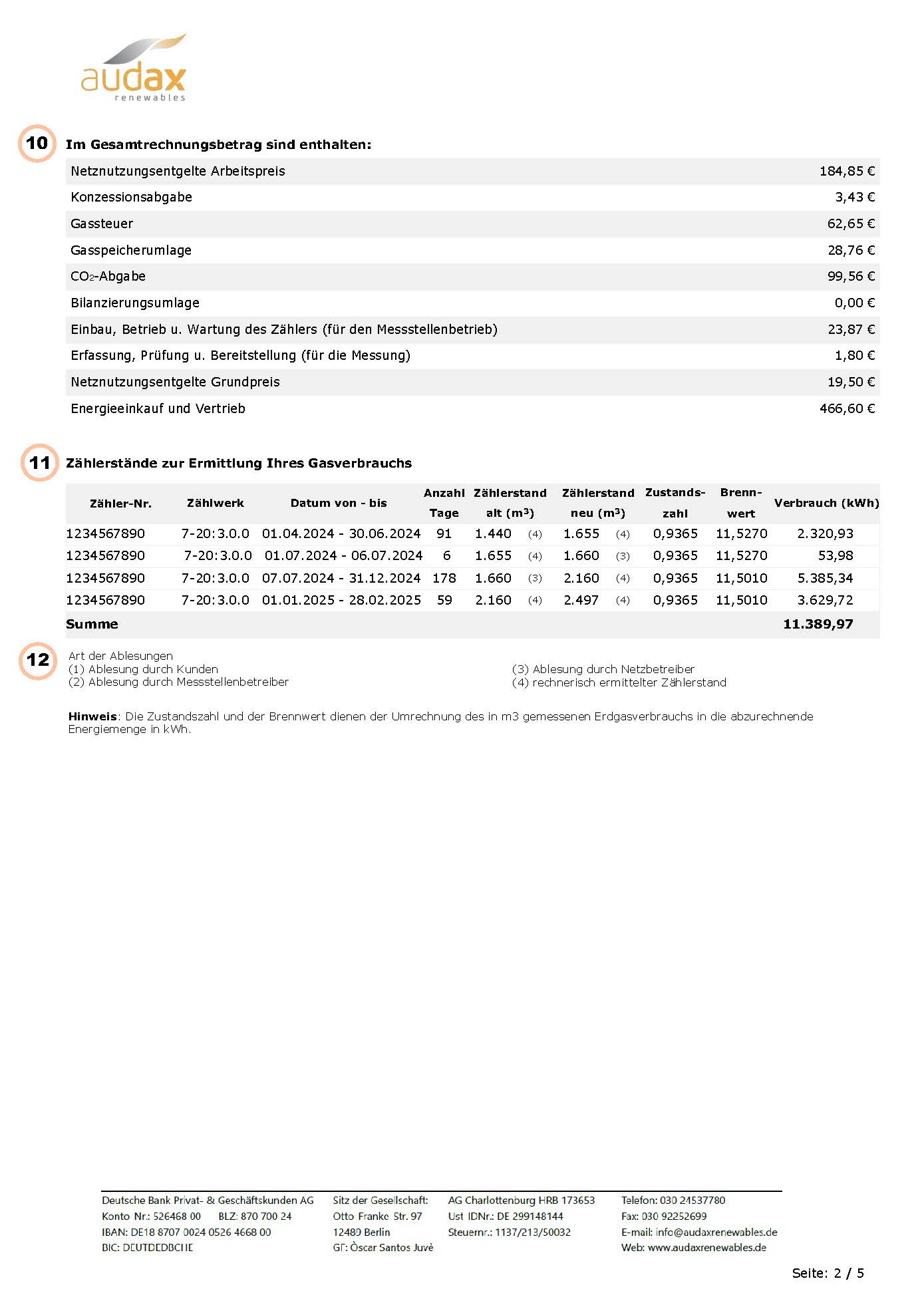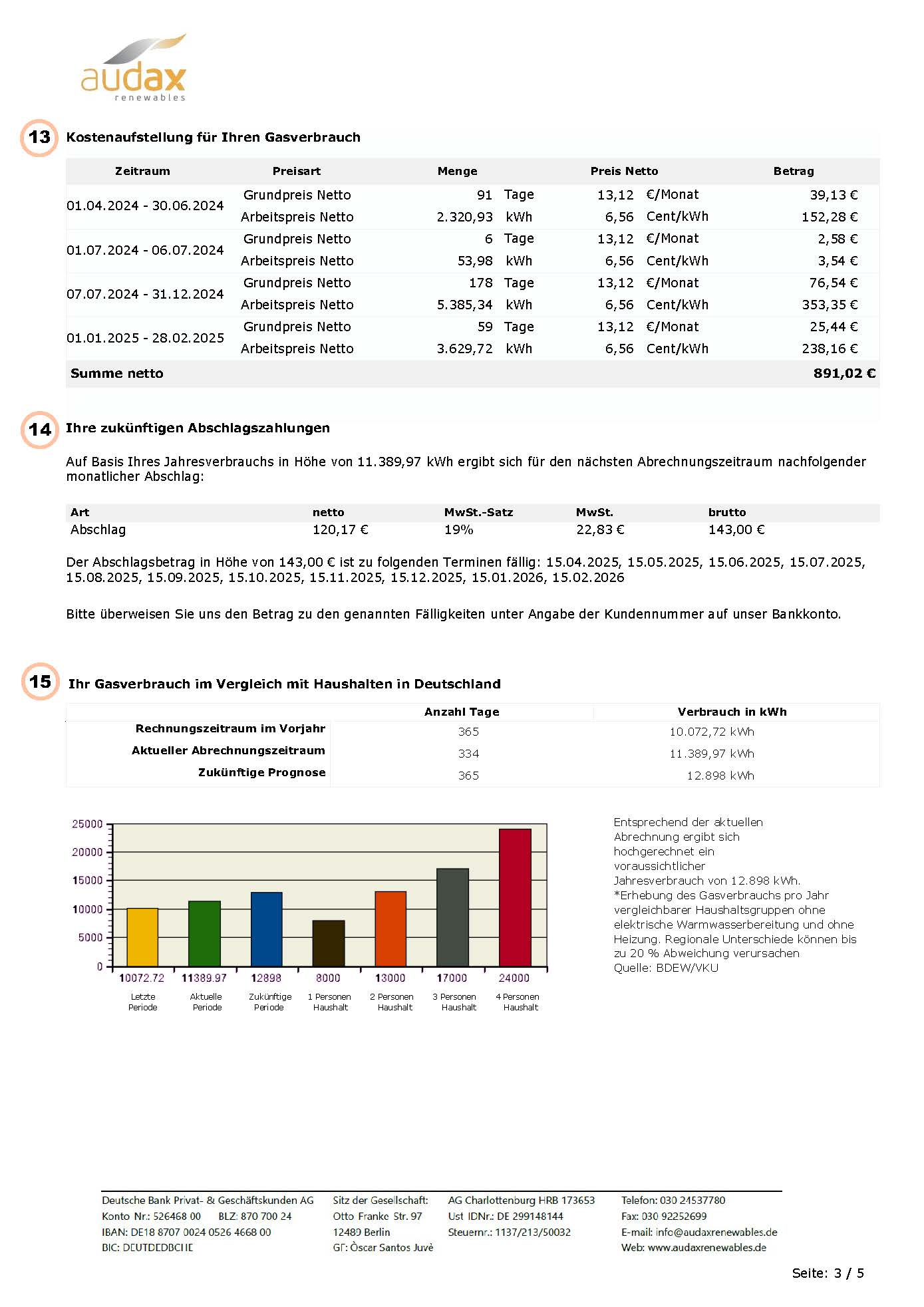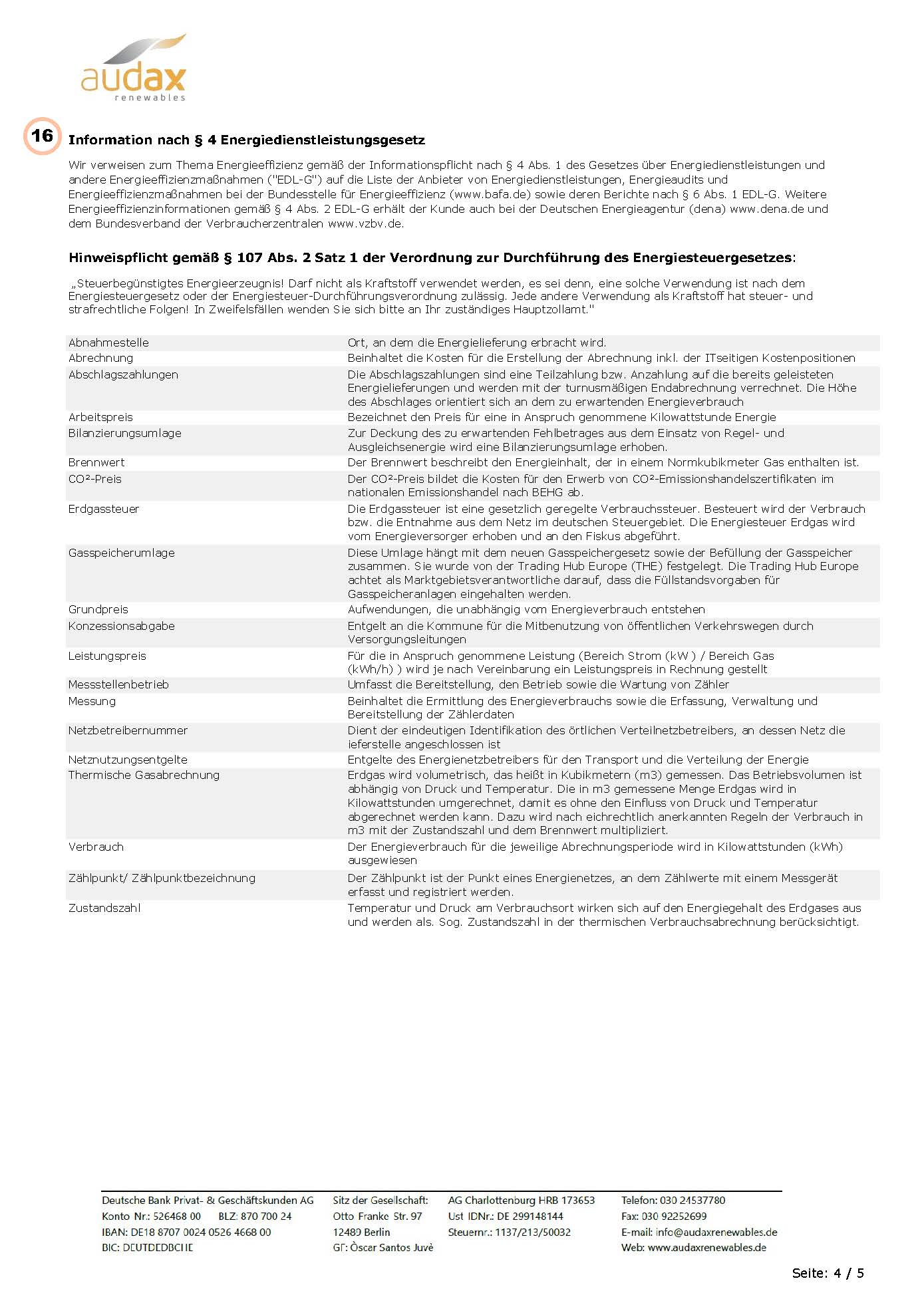Understanding the natural gas bill
We strive to make our electricity and gas bills as clear and understandable as possible. However, we recognize that some technical terms and specific information are not always immediately clear.
To help you navigate, we've created a sample calculation. Using this sample calculation, we'll explain the most important items, terms, and calculations step by step. This will help you better understand your own calculations and ensure you always understand exactly how the amounts are calculated.
Invoice explanation





When making bank transfers, please always include your customer number and invoice number as a reference so that your payment can be correctly recorded. Your customer number or contract number is also required for correspondence or inquiries so that we can process your request quickly and clearly.
Here you can see what type of bill you're dealing with. You'll typically receive an annual bill for your total energy consumption once a year. When your contract ends, for example, due to a move or termination, we'll issue you a final bill. You can also request an interim bill if you require a bill by a specific date.
Here you can see the connection for which the bill was generated. The meter number and market location are important for clearly recording your consumption and allocating it to you individually.
This indicates which company is responsible for network usage and which is responsible for reading and maintaining your meter. This information is required by law.
Your current tariff and its terms and conditions are listed here. This way, you know how long your contract lasts and when you can cancel.
This section of the bill shows an overview of your energy consumption costs, including VAT. Below that, the advance payments you've already made are taken into account. This ultimately results in the total amount. If your payments exceed the actual costs, a credit will be created that will be refunded to you. If your payments are less than the costs incurred, you'll have an additional payment, which must be paid by the due date shown.
Here you will find the amount you should transfer by the due date. You can find the bank details in the footer of the invoice.
If you've given us a direct debit mandate, we'll automatically deduct the amount from your account. A corresponding notice will appear directly on your invoice.
If you have a credit balance, we will transfer the amount to the account we have on file within two weeks. If we don't have your account details, please provide them later.
At the bottom of the invoice, you'll find our full contact details, including address, telephone number, and email address. Our bank details and other important information are also listed there.
This overview shows you exactly which components are included in your total bill. These include statutory charges such as concession fees and gas taxes, as well as network charges and surcharges for network operation. These costs are prescribed by law and are collected and passed on in the same way by all energy suppliers.
Also included are the costs for energy purchasing and distribution, i.e., the actual gas price and services. This gives you a transparent overview of the pricing structure.
In this section, you will find the time periods, the respective starting and ending readings, and the resulting kilowatt hours (kWh). Your consumption is displayed based on the meter readings. Please note that the meter readings are given in cubic meters (m3). However, since billing is done in kilowatt hours (kWh), the measured gas volume is multiplied by the calorific value and conversion factor.
The calorific value indicates how much energy is contained in the gas, while the conversion factor takes into account differences in pressure and temperature. This allows your actual energy consumption to be converted precisely and transparently into kWh.
The key explains how the individual meter readings were calculated: by your own reading, by the metering point or grid operator, or by calculation. This helps you immediately see whether the readings are actual or estimated. For estimates, we recommend checking the meter reading yourself and informing us of any discrepancies.
This table shows you the breakdown of your gas costs in detail. It shows the time periods, the amount consumed in kilowatt hours (kWh), and the respective prices per unit. This shows you exactly what costs were incurred for the base price (a fixed amount, regardless of consumption) and the energy price (per kWh consumed). The net total of all items is displayed at the bottom of the table. VAT is then calculated before the final amount is calculated.
A new monthly payment will be calculated based on your annual consumption and the current gas price. This fixed amount is due each month on a specified date. This spreads your energy costs evenly throughout the year, rather than having to be paid all at once.
In this diagram you can see how much your own annual consumption is compared to average households in Germany.
The last two pages of your invoice contain general and legally required information. We've also included brief explanations of important technical terms. This ensures that your invoice remains transparent and understandable for you at all times.
Explanations of terms
To make it easier for you to understand, we have summarized the most important technical terms from your invoice here and briefly explained them:
Point of consumption / point of consumption - Place where the energy supply is provided.
Advance payments - The advance payments are a partial payment or down payment on the energy already delivered and are offset against the regular final bill. The amount of the advance payment is based on the expected energy consumption.
Labor price - Refers to the price for one kilowatt hour of energy used.
Accounting allocation - A balancing surcharge will be levied to cover the expected shortfall from the use of control and balancing energy.
Calorific value - The calorific value describes the energy content contained in one standard cubic meter of gas.
CO² price - The CO² price reflects the costs for the purchase of CO² emissions trading certificates in the national emissions trading system according to the Federal Act on the Protection of the Environment (BEHG).
Natural gas tax - The natural gas tax is a legally regulated consumption tax. It is taxed on consumption or withdrawal from the grid within the German tax territory. The natural gas energy tax is levied by the energy supplier and remitted to the tax authorities.
Gas storage levy This surcharge is related to the new Gas Storage Act and the filling of gas storage facilities. It was set by Trading Hub Europe (THE). As the market area manager, Trading Hub Europe ensures compliance with the filling level requirements for gas storage facilities.
Base price - Expenses that arise independently of energy consumption.
Concession fee - Fees paid to the municipality for the shared use of public transport routes by utility lines.
Metering point operation - Includes the provision, operation and maintenance of meters.
measurement - Includes the determination of energy consumption as well as the collection, management and provision of meter data.
Network operator number - Serves to uniquely identify the local distribution network operator to whose network the delivery point is connected.
Network usage charges - Fees charged by the energy network operator for the transport and distribution of energy.
Thermal gas billing - Natural gas is measured volumetrically, i.e., in cubic meters (m3). The operating volume depends on pressure and temperature. The amount of natural gas measured in m3 is converted into kilowatt-hours so that it can be billed without the influence of pressure and temperature. For this purpose, the consumption in m3 is multiplied by the conversion factor and the calorific value, according to legally recognized standards.
consumption - The energy consumption for the respective billing period is shown in kilowatt hours (kWh).
state number - Temperature and pressure at the point of consumption affect the energy content of natural gas and are taken into account as a so-called energy conversion factor in thermal consumption billing.





